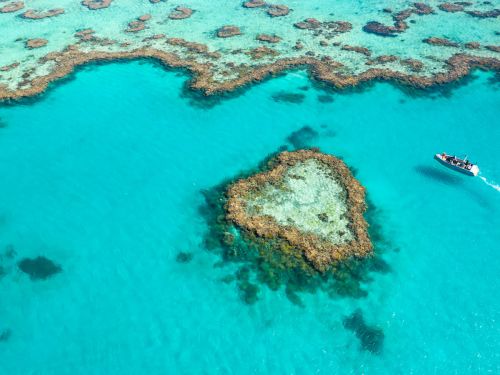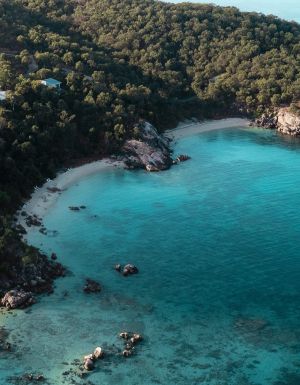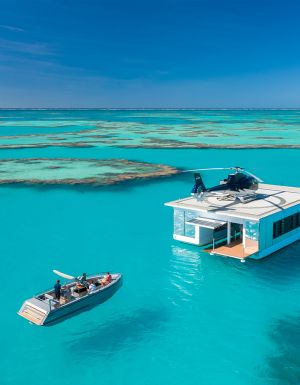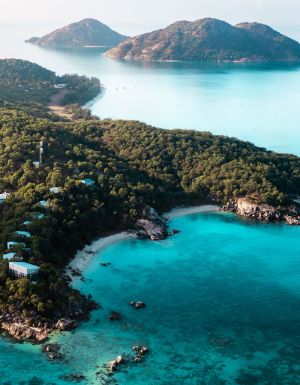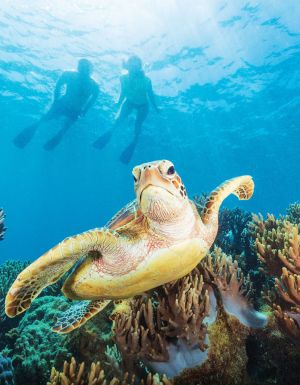Soak up every extraordinary inch of the world’s largest coral reef system with our round-up of the most fascinating Great Barrier Reef facts.
Sure, you can join a whistlestop tour or marvel at it from parts of Queensland’s mainland, but nothing immerses you in the enchantment of the Great Barrier Reef like scratching beyond the surface. The world’s largest living entity, recently nominated for the United Nations Environment Programme’s Lifetime Achievement Award (typically reserved for humans), is a profoundly complex and captivating natural wonder stretching across more than 348,000 square kilometres.
Filled with thousands of individual reefs and more than 900 islands, it’s a bucket list destination that must be experienced (several times over) to grasp its magnitude. From the environmental factors that threaten its existence to the string of world-class snorkelling and diving spots it boasts, reading up on essential Great Barrier Reef facts will only enhance your visit. Here, we round up the basics.
1. It’s estimated to be roughly 500,000 years old

According to multiple scientific reports, including one from the Great Barrier Reef Foundation , which was solely established to preserve and protect it, early sightings date back to more than 500,000 years ago — and potentially as far back as 600,000 years.
In terms of how it looks today, a major growth spurt occurred anywhere between 4,000 and 9,000 years ago, pushing new coral colonies to spread across the region. No matter how you carve it, the Great Barrier Reef is an ancient wonder.
2. You can see the Great Barrier Reef from space

The largest living structure on our planet, the Great Barrier Reef can be spied from as high up as space. It’s bigger than two Aussie states combined and larger than the entirety of Italy. Sweeping the Coral Sea from Bundaberg to Cape York, its expanse also sinks to extreme levels, notching up an average depth of 35 metres.
3. The best time to visit is during the dry season

While there’s never a terrible time to visit the Great Barrier Reef, you’ll likely experience less rain if you go during its dry season. Running from May to October, you’ll run into more clear skies above and fewer postponed boat excursions down low.
On the other hand, while November to May boosts a high chance of rain, water clarity is next level during these months. Epic manta ray and sea turtle selfies or guaranteed sunny backdrops? The choice is yours.
4. It’s a UNESCO World Heritage Site

In 1981, the Great Barrier Reef was officially crowned a UNESCO World Heritage Site, added to the World Heritage List for its ‘Outstanding Universal Value’. So what? Well, it’s significant as it propels support for the reef’s preservation and reiterates its cultural value. Other global sites include the Pyramids of Egypt, the Grand Canyon in the USA and the Galápagos Islands in Ecuador — so we’re hanging with pretty solid company.
5. It is globally renowned for its biodiversity

A staggeringly complex collection of more than 300 coral reefs, the Great Barrier Reef is home to more than 400 coral species, 1,500 fish species, six of the world’s seven marine turtle species, 2,000 square kilometres of mangroves and so much more. It supports much of the marine life Australia is renowned for, including dugongs. The reef is home to major dugong feeding grounds, creating one of the world’s largest dugong populations.
While we’re throwing out impressive numbers, add 30 species of whales and dolphins, more than 240 bird species and thousands of plant species to its roll call before you even consider counting each coral cay’s unique flora and fauna.
6. It’s threatened by a string of natural factors

Sadly, natural elements serve as the biggest threat to the Great Barrier Reef. Rising sea temperatures affect coral livelihood and often lead to coral bleaching, where coral struggles to recover. Additionally, marine species are forced to search for cooler waters, meaning there’s impossible competition for food and shelter.
Declining water quality from land-based run-off is also bringing pesticides and other pollutants into the sea.
7. It’s also threatened by human interference

Responsible commercial fishing practices are crucial in keeping the Great Barrier Reef safe. These practices, which include limiting fishing licences and restricting vessel capacity and sizes, work to prevent overfishing and the fishing of endangered species.
Additionally, pollution, plastic particularly, is also a key driver when it comes to the reef’s decline. Plastic effortlessly smothers seagrass beds and corals, blocking the sun from nourishing it and encouraging the growth of invasive dangers like the crown-of-thorns starfish.
8. It’s home to some of Australia’s most pristine islands

Home to almost 1,000 islands in total, the Great Barrier Reef is where you’ll find the likes of Hamilton Island, Lizard Island, Lady Elliot Island and other highly coveted holiday hot spots. No matter where you point your compass, powdery white sand, rippling turquoise waters and outstanding snorkelling and diving hot spots abound.
9. You can spend a night under its waters

Embrace responsible tourism throughout the Great Barrier Reef via environmentally friendly accommodation picks. Arguably the most unique is Australia’s first underwater hotel, Reefsuites . Guests are invited to lie in bed and watch as incredible marine life flutters beyond floor-to-ceiling windows. Two room styles are available — either a king double or twin single variety — and all meals are included in every stay.
10. Heart Reef remains one of its most popular attractions

One of the best day trips departing off Hamilton Island, Heart Reef is a tiny cluster of coral that has created the shape of a heart, especially when viewed from above. Simple to snap while exploring the Great Barrier Reef through one of its best aerial-based tours (more on touring the Great Barrier Reef below), the highly Instagrammable attraction is located within Hardy Reef, less than 10 kilometres from the Reefworld pontoon, which houses the glorious Reefsuites.
11. Cairns and Port Douglas offer easy day trip access

Serving as the main ports for Great Barrier Reef day tripping, Cairns and Port Douglas are magnets for active holiday makers. The most responsible way to comb through the highlights is via one of the reef’s most environmentally conscious tours, blending first-hand insight (often from marine biologists) with expert navigation throughout the region’s ultra-vibrant sights.
12. Visitors can help cement a sustainable future

There’s plenty more work to be done in ensuring the Great Barrier Reef remains as spectacular as it stands today. Play your part by choosing eco-conscious tours, which also support sustainable tourism, steering clear of physically touching coral, opting for mineral sunscreen rather than chemical-based varieties and removing litter where you can. They’re simple gestures but don’t underestimate their impact — our most beautiful natural creation requires more than a sliver of our attention.
Discover the best Great Barrier Reef accommodation near the Great Barrier Reef


